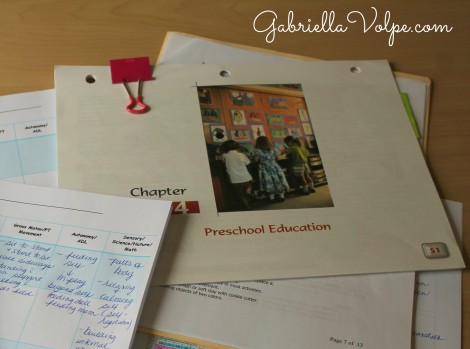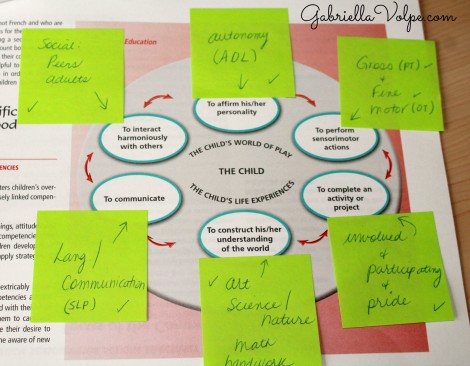This is part 5 of the planning series. If you haven’t read the other parts yet, I encourage you to do so before reading below since each part builds upon the next.
Part 1 – Defining your family’s philosophy of education
Part 2 – Finding your child’s preferred “intelligence(s)” and learning style
Part 3 – Educational styles
Part 4 – Locate your region’s curriculum/educational program
In this post, you’ll learn about the important elements needed to adapt/modify the curriculum and the difference between the two.
You likely have questions about how to adapt your province/state’s somewhat complex curriculum to your child’s unique needs.
Readiness requires time for your child and belief on your part
Set goals based on where your child is at.
If you assess your child’s readiness for “school” years before they’re developmentally ready, you may be setting your child up for frustration. I never recommend pushing “schooling” before children are ready or of legal school age, whichever comes first. And, even then, it doesn’t need to be school-at-home. Learning can and should honor the child.
Defining “Adaptation” and “Modification”
You’ve probably heard these words tossed around and might even believe they are one and the same.
Adapting a curriculum means taking the provincial/state curriculum and working towards the goals in methods that most meet your child’s learning style and intelligence(s). What gets changed or adapted is the approach used for your child to acquire those standards/competencies. Adaptations are usually made for the child who can follow grade-level standards (more or less) but who needs to learn in a specific way—such as using manipulatives or by being given extra time to complete a task so that they can work at their own pace. In essence, barriers to learning are reduced or removed.
When modifying a curriculum/program, the changes are made to the standards/competencies because your child cannot meet them at this time. Children often work on a modified program in school that is individual to their ability level (not age or grade level). In-home education it’s just called learning.
How do you know which your child will need?
Your child knows and demonstrates this to you daily.
Where do you begin to make adaptations and modifications?
How to break ground with this?
If you are unschooling, there is no need to make adaptations/modifications because you’re already following the child’s lead. However, if you’re taking on a more formal approach, follow the steps below. These steps are also helpful for states/provinces, like Quebec, that have specific rules for reporting to the Ministry of Education.
Four pieces of information to gather:
1- A copy of your province or state’s curriculum/ educational program (as discussed in part 4).
2- The most recent evaluation you have available from your child’s school (if your child was not homeschooled last year), the rehabilitation center your child receives services from, or a psychologist. It could also be the most recent IEP if your child has one.
3- A list of your goals for your child. Besides all of the Ministry of Education’s requirements, what does your child want to achieve this year? These goals might overlap the latest formal assessment if those points were included at the time of the meeting. However, at times, there is such a large gap between the time that assessment was done, the time the report came out, and the time your child is actually ready for “school.” Even one month can bring on changes in your child, requiring new goals.
4- Your child’s preferred “intelligence(s)” and learning style (part 2 in this series).
Read or reread these documents/lists and combine the four in order to create a modified or adapted program.

The Quebec Education Program, the latest assessment, my own goals, and my son’s preferred learning style helps me to modify the curriculum.
What kind of adaptations can you make?
The list is endless, but here are some things to consider:
- Positioning – Standing, sitting at a desk, sitting on the floor, sitting on a chair, kneeling, etc.?
- Pace – What pace does your child need to learn, practice, and master a task?
- Time – How much “space” to absorb the learning does your child need? Sometimes, moving on to something else and coming back to the concept makes a world of difference. Sometimes, repetition over several days works better.
- Limiting the amount of work – Rather than piling your child on with tons of math exercises, limit to 3-5 (or another number appropriate for your child).
- Physical Space – Indoors, outdoors, in the car?
- Teaching to learning style/dominant intelligence(s) – Hands-on, auditory, visuals, etc.
- Tools – What kinds of manipulatives/materials/tools are best for your child? A computer? A tablet? Adapted scissors? Etc.
- Time of day – Morning, afternoon, evening, before or after a mealtime?
- Type of activity – Fine motor, gross motor?
- Day of the week – Are weekends better for certain activities (doesn’t need to be Monday through Friday with homeschooling!) while your significant other is around to help?
Important note: Be sure the goals are neurodiversity- and disability-affirming. The idea is to create goals that reduce or remove barriers to learning, not to “fix” or change the child. Further, goals should always be set with and not for the child.

In order to modify the curriculum for my son, I’ve taken the Ministry standards/competencies and meshed them with his most recent evaluation, added my goals and his learning style and have started brainstorming possible changes for him. The sticky notes are just links I’ve made to all four elements—making it clearer to me what needs to be modified and how.
What type of modifications can you make?
Modifications are more specific because each child is different, and the modifications will never be the same for any two children. You will need to look at what your child can do and what they are expected to do by the grade level that matches best (based on the standards/competencies) and make the changes accordingly. Your child should be challenged enough to move on to the next skill level but not so much so that the goal is unattainable.
What questions do you have regarding making adaptations or modifications for your child?
Devising adaptations and modifications is an individual task that requires extended consideration. I can help you make the changes you need through a private consultation.

0 Comments